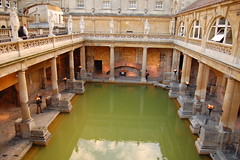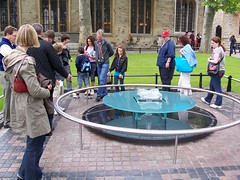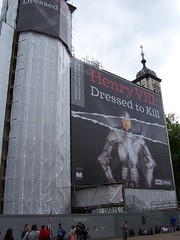 Two weekends ago found us in the lovely city of Bath. At various points in its history, Bath has been home to King Bladud, the ninth English king, Jane Austen, Leah's favourite author, and a whole lot of Romans bathing in a whole lot of water. It is conveniently only 90 minutes from London (if you get the train; it's three hours if you get the bus), and is legendary for its healing powers.
Two weekends ago found us in the lovely city of Bath. At various points in its history, Bath has been home to King Bladud, the ninth English king, Jane Austen, Leah's favourite author, and a whole lot of Romans bathing in a whole lot of water. It is conveniently only 90 minutes from London (if you get the train; it's three hours if you get the bus), and is legendary for its healing powers.The first historical location we visited was the Jane Austen Centre, home to the Jane Austen museum and the Regency Tearooms. The Centre is a few doors down from one of Jane Austen's many homes in Bath. Jane and her family moved to Bath from the country, but unfortunately she didn't like it very much and her writing suffered - she didn't write any books during her 5 or so years there. While they were in Bath her father died, and with that their pension disappeared so they gradually slipped down the social ladder, eventually ending up in Trim St which was not a very desirous neighbourhood. Once Jane left Bath her writing picked up again, but she died in 1817 aged only 41.
Aside from her life story, the Centre also told you about society at that time, and let you practice fan language (see photos). They also serve traditional high tea, and cream teas, up in the Regency Tearooms, so we felt we should try and be proper English people by having scones and tea. They were delicious :)
 We also visited the Roman Baths, and did so in the evening as they have late nights in summer (closing at 10pm). There's an audio guide which gives you heaps of detail about everything you see, and the history of the site. They have found parts of the Roman Temple to Minerva that was there, and have reconstructed the entire pediment from just a few remaining pieces. They have recovered all sorts of things from the spring and surrounding areas, like notes to the goddess that were thrown in, cursing people who had stolen things. These survived because they were written on metal and folded up. They also found beautiful engraved gems from signit rings which had either been thrown in as a sacrifice or lost from the bearer's ring as the water dissolved the cement.
We also visited the Roman Baths, and did so in the evening as they have late nights in summer (closing at 10pm). There's an audio guide which gives you heaps of detail about everything you see, and the history of the site. They have found parts of the Roman Temple to Minerva that was there, and have reconstructed the entire pediment from just a few remaining pieces. They have recovered all sorts of things from the spring and surrounding areas, like notes to the goddess that were thrown in, cursing people who had stolen things. These survived because they were written on metal and folded up. They also found beautiful engraved gems from signit rings which had either been thrown in as a sacrifice or lost from the bearer's ring as the water dissolved the cement.The baths are a couple of metres below street level, and the foundations, floors, pieces of the walls and roofs are still intact. Apparently the roof would have stood 20m above the baths, which is as high as the surrounding buildings. Today the bath is open to the air and is a lovely green colour due to the sunlight encouraging algae to grow, but back then it would have been more appealing. You could see the under-floor heating system that they built, as well as the drain that takes the overflow from the spring out to the river -- it's big enough to walk down.
 After visiting the baths you get to try some of the spring water (renowned for their healing powers), so of course we did, and you can see the effect it had on us.
After visiting the baths you get to try some of the spring water (renowned for their healing powers), so of course we did, and you can see the effect it had on us.The Bath Abbey was founded in the 7th century, and most recently rebuilt in the 1600s, and was the last church to be built before the Reformation. It's quite big and has some lovely stained glass, as well as lots of tombstones in the floor and walls. We did a tour of the Bell Tower which was very interesting, and told us all about how the bells are rung. They have 10 bells, the largest of which weighs 1.5 tonnes and once fell off its framework causing a bit of damage and meaning that it had to be recast. There are several different ways that the bells can be rung: manually by ten people (the traditional way), manually by one people (just a matter of pulling strings on the wall), automatically by a fancy box on the wall, automatically by a music box type arrangement, and automatically by an engine (this one does the quarter hours and hours).
We got shown the back of the clock which was something you don't see every day, but it had what looked like a very simple mechanism. We also got to stand on the top of the vaulted ceiling, and looked down through a hole all the way down to the Abbey floor. Then we went up to the top of the tower and took lots of photographs.
The council runs free walking tours of Bath twice a day, so we took advantage of that and went for a two hour informative walk of the city. Highlights included:
- Pulteney Bridge, one of not many bridges that have shops on it. In fact, when you walk across it you can't even tell you're on a bridge -- it just looks like a normal road.
- The Guildhall. From the outside it has seven windows across it, but on the inside there are only six: the middle one is a fake to make it look nice, and in fact has a fireplace behind it, with a chimney disguised as a decoration on the roof.
- The various styles of architecture. Most of the houses are Georgian, which is very regular and geometric. There is also some Elizabethan architecture, which uses irregular stones, has small panes of glass in the windows, and has steep roofs to throw off the rain and snow. The Circus is a fine example of the city's architecture, and has houses in three levels with columns (Doric, Ionic, Corinthian) going up and getting slimmer to make the building seem light. It also has acorns on top of it which is pretty awesome*. The Royal Cresent is a huge crescent of buildings looking like a big palace, and is very impressive. Also, almost all of the buildings are made of Bath stone, which looks like Oamaru stone, so they're all the same colour and style and therefore a bit repetitive if you're not a fan of architecture.
 While we were in Bath we visited some distant relatives in the nearby town of Bradford-on-Avon, which is a charming wee place with narrow winding streets, a Saxon church, and a big old barn. While we were there we enjoyed playing with a tiny puppy, and watching one of their daughters learn to ride a bike. We also had our first 99 icecream, which is vanilla icecream in a cone with a flake. It doesn't cost 99p though, so we're confused about the name.
While we were in Bath we visited some distant relatives in the nearby town of Bradford-on-Avon, which is a charming wee place with narrow winding streets, a Saxon church, and a big old barn. While we were there we enjoyed playing with a tiny puppy, and watching one of their daughters learn to ride a bike. We also had our first 99 icecream, which is vanilla icecream in a cone with a flake. It doesn't cost 99p though, so we're confused about the name.All in all, we enjoyed our trip to Bath. Although it lacks some of the quaintness that other historical cities have, it is still a friendly city, and certainly easy to explore. And if you're curious about the water -- it tastes vaguely eggy, like you'd expect the water to taste after you boiled an egg in it. It's served warm, too.
* The legend goes that Mr Bladud, then a pig boy, was walking his pigs when they found some mud and wouldn't get out. The only way he could entice them out was by laying down a trail of acorns for them to eat. As they came out of the mud he noticed they were all miraculously cured of their ills, so he had a dip and noticed the same. He then went on to reclaim his rightful position, become king, and learn to fly. We're not making that up.
Take a look at our photos (if you want to).


